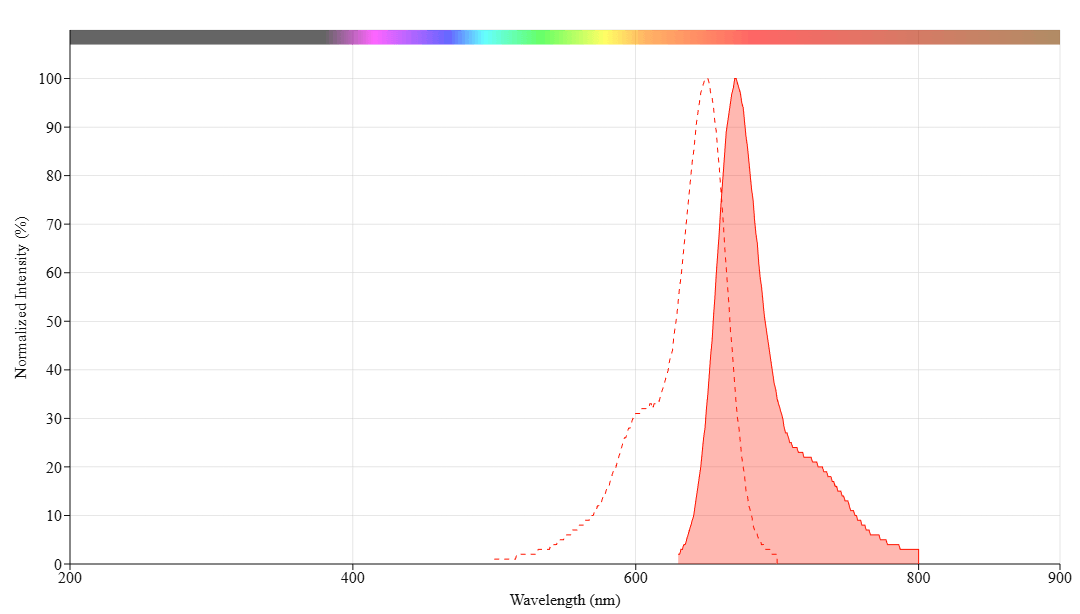XFD647 Azide
Product key features
- Ex/Em: 650/671 nm
- Extinction coefficient: 270,000 cm-1M-1
- Reactive Group: Azide
- Click Chemistry Conjugation: Efficiently and rapidly labels terminal alkynes via CuAAC and copper-free SPAAC
- Bright & Stable: Delivers intense fluorescence with resilience to photobleaching and pH variations from 4 to 10
- Hydrophilic: Minimizes aggregation, enhancing signal clarity for advanced imaging and live-cell studies
Product description
XFD647, manufactured by AAT Bioquest, is a bright far-red flurosecent dye structurally identical to Alexa Fluor™ 647 (ThermoFisher). It is efficiently excited by the 594 nm or 633 nm laser lines and is compatible with RFP filters like Cy5, making it well-suited for applications such as fluorescence microscopy and flow cytometry. XFD647 exhibits excellent aqueous solubility and pH stability across a wide range (pH 4–10), ensuring robust signal reproducibility under diverse experimental conditions. The dye enables high-degree conjugation to biomolecules with minimal self-quenching, resulting in enhanced fluorescence intensity and signal stability. Additionally, its high fluorescence quantum yield and superior photostability facilitate the sensitive detection of low-abundance targets, enhancing precision and sensitivity in quantitative fluorescence-based assays.
The azide derivative of XFD647 is widely used for labeling terminal alkynes on peptides, antibodies, and other biomolecules via click chemistry. It participates in copper-catalyzed azide-alkyne cycloaddition (CuAAC) with alkyne-containing molecules and strain-promoted alkyne-azide cycloaddition (SPAAC) with DBCO- or BCN-containing molecules.
Spectrum
Product family
| Name | Excitation (nm) | Emission (nm) | Extinction coefficient (cm -1 M -1) | Correction Factor (260 nm) | Correction Factor (280 nm) |
| XFD488 azide *Same Structure to Alexa Fluor™ 488 azide* | 499 | 520 | 71000 | 0.30 | 0.11 |
| XFD555 azide | 553 | 568 | 150000 | 0.08 | 0.08 |
| XFD635 azide | 633 | 647 | 140,000 | - | - |
| XFD647 TCO | 650 | 671 | 239000 | 0.00 | 0.03 |
| XFD647 Tetrazine | 650 | 671 | 239000 | 0.00 | 0.03 |
| XFD680 azide | 681 | 704 | 184000 | 0.00 | 0.05 |
| XFD700 azide | 696 | 719 | 192000 | 0.00 | 0.07 |
| XFD750 azide | 752 | 776 | 240000 | 0.00 | 0.04 |
| XFD790 azide | 782 | 805 | 260,000 | 0.09 | 0.08 |
Show More (3) | |||||
References
Authors: Willén, Daniel and Mastio, Roberto and Söderlund, Zackarias and Manner, Sophie and Westergren-Thorsson, Gunilla and Tykesson, Emil and Ellervik, Ulf
Journal: Bioconjugate chemistry (2021): 2507-2515
Authors: Koch, Peter D and Quintana, Jeremy and Ahmed, Maaz and Kohler, Rainer H and Weissleder, Ralph
Journal: Advanced therapeutics (2021)
Authors: Spiciarich, David R and Nolley, Rosalie and Maund, Sophia L and Purcell, Sean C and Herschel, Jason and Iavarone, Anthony T and Peehl, Donna M and Bertozzi, Carolyn R
Journal: Angewandte Chemie (International ed. in English) (2017): 8992-8997
Authors: Bennett, Kristen and Sadler, Natalie C and Wright, Aaron T and Yeager, Chris and Hyman, Michael R
Journal: Applied and environmental microbiology (2016): 2270-2279
Authors: Rehor, Ivan and Lee, Karin L and Chen, Kevin and Hajek, Miroslav and Havlik, Jan and Lokajova, Jana and Masat, Milan and Slegerova, Jitka and Shukla, Sourabh and Heidari, Hamed and Bals, Sara and Steinmetz, Nicole F and Cigler, Petr
Journal: Advanced healthcare materials (2015): 460-8




